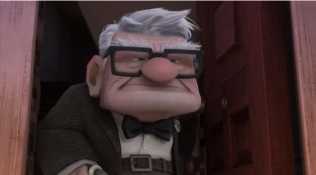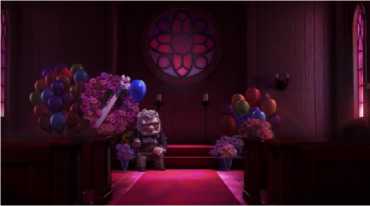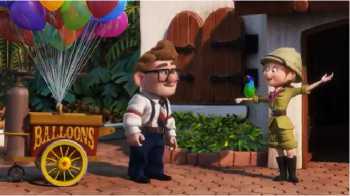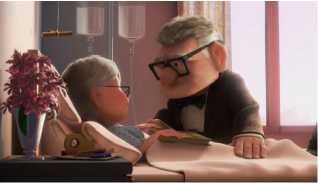Three Dimensions Analysis of The Main Character in UP Movie
on
Udayana Journal of Social Sciences and Humanities, Vol. 7 No. 1, February 2023
DOI: https://doi.org/10.24843/UJoSSH.2023.v07.i01.p04
19
Three Dimensions Analysis of The Main Character in UP movie
Ni Putu Intan Gustianingsih 1, I Gusti Ayu Gede Sosiowati2, and I Komang Sumaryana Putra3
Udayana University: English Department1
Faculty of Humanities1
Denpasar, Indonesia1
Email: intangustianingsih@gmail.com1
Udayana University: English Department2
Faculty of Humanities2
Denpasar, Indonesia2
Email: sosiowati@yahoo.com2
Udayana University: English Department3
Faculty of Humanities3
Denpasar, Indonesia3
Email: sumaryana_putra@unud.ac.id3
Abstract: The aim of this study is to analyse the three dimensions of the main character in UP movie. The data which are used in this study are taken from a movie entitled UP. This study applied a theory proposed by Egri (1960) to analyse the three dimensions of the character. The data were collected by using documentation method and note taking technique. Descriptive and qualitative method were used to analyse the data. Based on the analysis, it shows that the main character in UP movie is Carl Fredricksen. In the movie, it shows all of the three dimensions of the character. The physiological dimension of Carl is Carl is an elderly. Based on the sociological dimension, Carl is a widower, a retired man, and he has a bad relationship with construction workers. Based on psychological dimension, Carl was quiet and shy when he was child, after the death of his wife he becomes short-tempered and stubborn but actually a nice person, Carl is faithful and loves his wife, and he also a smart person.
Keywords: main character, physiological dimension, psychological dimension, sociological dimension, three dimensions.
-
I. INTRODUCTION
Literature is a medium for human being to present their ideas, imagination, and feeling through language. There are many form of literature like short story, poem, and novel, besides that there are adaptation of literary work such as musical poetry, drama and movie (modern drama). Lately movie become popular and it is loved by many people. According to the Oxford Dictionary (2015), movie is a story or event recorded by a camera as a set of moving images and shown in a theatre or on television. Literature can be fiction or non-fiction. Non-fiction is based from reality, meanwhile, fiction is a creation that not real but can be inspired by real life. One of important element of a story is character. According to Cuddon (2013) Character is the person portrayed in a narrative or dramatic work. Fiction
character is not real but it is inspired by reality. The character usually related to us in the reality, it can have the similar personality or condition in real life. According to Kenney (1966) a character in a fiction is expected to be lifelike or similar to people life. The lifelikeness of the character can make the reader or audience can relate to the character. It is the reason why analysing a fictional character in a story is interesting. According to Tarigan (1984), Character can be devided into three, main character, secondary character and supporting character. This study is focused on analysing the main character. The main character is the character which is become the central of the story. In this study, the character is analysed by using a theory proposed by Egri (1960). According to him, character can be analysed based on the three dimensions of character: physiology, sociology, and psychology. This
study is focused on analysing the main character based on three dimensions of the main character in UP movie, it includes the physiological, sociological, and psychological dimension of the Character. UP movie is used as the data source because it has an interesting main character and a good story. This study is expected to enlarge the knowledge about character in a story and also this study can be used as a reference for another researcher who is interested with the same topic.
-
II. Method and Theory
The data which are used in this study are taken from a movie entitled UP and its subtitle. UP is an animated movie which is producted by Pixar Animation studio and released by Walt Disney pitcures. The movie is directed by Pete Docter and co-directed by Bob Peterson. The story is written by Pete Docter, Bob Peterson, and Tom McCarthy. The duration of the movie is 96 minutes. The researcher used documentation method and note taking technique to collect and gather the data. To analyse the data, descriptive and qualitative method were used in this study. The steps to analyse the study. The steps of collecting the data and analysing the data: watching UP movie on Disney Plus, seeing the subtitle to help understand the story, using note taking technique to collect the data from the movie, does screen shoots to captures several scenes in the movie which is related to the topic, analysing the data by using Egri’s theory (1960), drawing the conclusion based on the analysis.
This study uses a theory proposed by Egri (1960) from his book entitled The Art of Dramatic Writing. Acording to Egri, Human has three dimensions: physiology, sociology, and psychology. The three dimension also can be applied on analysing character in a story. Physiology is talking about the appearance of the character, it about how the character looks, their age, their gender, height, weight, posture defect and heredity. Sociology is related with the social life condition of the character such as social class, the occupation (the type of work, hours of work, income, condition of work, attitude toward org anization, suitability for work), education, the home life of the character, religion, race, nationality, place in community, political affiliations, amusements, and hobbies. Psychology is related to psychological condition of the character, it includes the moral standards, sex life, personal premise, ambition, frustration, chief dissapointments, the temperament (choleric, easy-going, pessimistic, optimistic), the qualities (such as imagination, judgement, taste, poise), attitude toward life (resigned, militant, defeatist), extrovert, introvert, ambivert, abilities (such as languages and talents), and IQ.
-
III. Result and Discussion
This study is analysing the three dimensions of the character in UP Movie. Based on analysis, Carl is the main character in UP movie. Carl is the central of the movie. All
scenes in the movie are related to Carl.
Three Dimensional Character Analysis of The Main Character.
-
1. The Analysis of Physiological Dimension of the Main Character
Physiological dimension is discussing about the appearance of the character or how the character looks. In the movie it shows that Carl is an elderly man. It can be seen on figure 1, Carl is portrayed as an old man, he has white hair and wrinkled skin. Carl has blue eyes, a big nose, and wears square-shaped sunglasses, perhaps he has trouble with his eyesight which makes him wear glasses. Besides that the other proof that Carl is an elderly can be seen on data 1, the quotation “I'm elderly and infirm”, It can be seen that Carl calls himself as an elderly. Carl admits that he is not young and his body is not as fit as when he was young.

Figure.1 Carl Fredrickson (15:23)
Data 1
(17:08 – 17:14)
CARL : Bird. Beady eyes. Every night it sneaks in my yard and gobbles my poor azaleas. I'm elderly and infirm. I can't catch it. If only someone could help me –
Sociological dimension is talking about the condition of social condition of the character. It shows in the movie that Carl is a widower, retired, and has a bad relationship with construction workers.
-
a. Carl is a widower
In the movie (7:17 – 11:15 ) shows that Carl married his childhood friend named Ellie. Ellie is a tomboy girl who has the same idol with Carl They become a happy couple but does not have child. But then Ellie passed away because of sickness when she becomes elderly. In Ellie’s funeral ceremony, Carl is still feeling sad with the death of her wife (It can be seen on figure 2)

Figure. 2 Carl attends Ellie’s funeral ceremony (11:15)
In the movie (8:01 – 8:13) shows that Carl had worked as a balloon salesman. Figure 3 shows that Carl brings a balloon cart and wears a uniform meanwhile Ellie wears Zookeeper’s uniform. It proves that Carl’s job was a balloon salesman, he worked in a zoo with his wife (Ellie) who works as Zookeeper in a Zoo. After the death of his wife, Carl is retired from his job. It can be seen on data 2, when he receives a letter from his brother, there is a pamphlet about a retirement village named Shady Oaks. Carl’s brother suggests Carl to move to a retirement village. It can be concluded that Carl is already retired from his job as a balloon salesman.
Data 2 (13:48-14:09) CARL: Uhp, mail's here.
CARL: Shady Oaks Retirement. Oh brother.
Carl lives alone in his house after the death of his wife. Carl’s house is in the middle of many construction buildings, Carl’s house is the only house which is still stayed there. There are many construction workers surrounding his house who make noisy sounds when they are working. Carl does not like what the construction workers do. When Carl is about to cleaning his mailbox, one of the construction workers approaches him and asks him if he needs any help or not, Carl answers it by complaining.
Data 3
(14:17 – 14:26)
CONSTRUCTION FOREMAN TOM: Hey `Morning, Mr. Fredricksen Need any help there?
CARL: No. Yes. Tell your boss over there that you boys are ruining our house.
From data 3, the quotation ““Tell your boss over there that you boys are ruining our house”, “you boys” here refers to the construction worker, it can be concluded that Carl feels annoyed with the construction workers. Besides that, when the construction worker tries to tell Carl to sell his house, Carl refused the offer and he blows the construction worker’s face by using his leaf blower. It can be seen from the conversation on data 4:
Data 4
(14:47 – 14:39)
CONSTRUCTION FOREMAN TOM: Well just to let you know, my boss would be happy to take this old place off your hands, and for double his last offer. Whaddya say to that?
(Carl blows the construction worker face’s by using his leaf blower)
CONSTRUCTION FOREMAN TOM: Uh, I take that as a no, then.
Carl also does not like the boss of the construction workers. It can be seen on data 5, the quotation “You poured prune juice in his gas tank.” It shows that Carl does disrespect things to the boss of the construction workers by pouring prune juice in his g as thank. From the quotation “You in the suit. Yes, you. Take a bath, hippy ” The word “you” here refers to the boss of the construction worker, it shows that Carl also insults the boss of construction workers by calling him a hippy.

Figure. 3 Carl and Ellie worked at Zoo (8:07)
Data 5
(14:43 – 14:56)
CARL: I believe I made my position to your boss quite clear.
CONSTRUCTION FOREMAN TOM: You poured prune juice in his gas tank.
CARL: Oh yeah, that was good. Here, let me talk to him. (Tom hands Carl his MEGAPHONE.)
CARL (in megaphone): You in the suit. Yes, you. Take a bath, hippy
The Psychological dimensions of the character explains the psychological condition of the character. It can be analysed from many aspects such as the attitude of the character, IQ, temperament, and IQ. The analysis of psychological dimension of the main character:
When Carl was still a child, he was a shy and quiet person did not talk much. In the movie, Ellie is the one who dominating the conversation, Carl only answers Ellie’s question by nodding or shaking his head. His act makes Ellie thinks that Carl could not talk, Ellie also says that Carl does not talk much. It can be seen through data 6 and 7: Data 6 (4:17 – 4:20)
YOUNG ELLIE: What's wrong? Can't you talk?
Data 7
(7:04-7:09)
YOUNG ELLIE: You know, you don't talk very much. I like you.
Based on data 6, the quotation “What's wrong? Can't you talk?”, shows that Ellie is confused why Carl does not answer her question, she assumed that Carl cannot talk. At that time, Carl is too shy to talk at the moment. Based on data 7, the quotation “You know, you don't talk very much. I like you”, it shows that Carl is a quiet person who rarely talks. But when Carl turns older Carl does not shy and quiet anymore.
In the movie (8:45 – 9-18) shows that Carl is still loves his wife even though she cannot have a child, Carl tries to cheer her up when she is sad about the fact that she cannot have a child. Carl gives Ellie her adventure book which makes her remembers about their past promise to visit paradise Falls, they start to save money to visiting Paradise Falls. It makes Ellie becomes happier and does not sad anymore. In the movie (10:28 – 11:09), when Carl and Ellie became old, Carl remembers about their promise to visit Paradise Falls in South America. Carl wants to surprise his wife with two tickets trip to South America, but before showing the tickets, Ellie fells ill. In the movie shows that Carl is still on her side when she is sick (It can be seen on Figure 4). Ellie passed away soon after.

Figure. 4 Ellie was sick (10:57)
Carl still loves his wife even if she already passed away. In the movie, Carl also tries to takes his house to Paradise Falls in order to fulfill his promise to his wife. On data 8, it shows that when Carl is on his way to Paradise Falls, he mentions Ellie’s name. He tells Ellie that they are on the way to Paradise Falls to fulfill their promise. It proves that Carl is still love and faithful to his wife.
Data 8
(23:24 – 23:28)
CARL: We're on our way, Ellie.
-
c. Carl is a stubborn person
Carl can be considered as a stubborn person. Carl becomes stubborn if it is related to something that important to him. In the movie shows that his house is really important to him. The house has many memories of him and Ellie. It makes him does not want to move to other place. When a construction worker offers Carl to sell his house, he refuses it.
Data 9
(14:59-15:08)
CONSTRUCTION FOREMAN TOM: This is serious. He's out to get your house
(Carl walks to his front door.)
CARL: Tell your boss he can have our house.
CONSTRUCTION FOREMAN TOM: Really?
CARL : When I'm dead!
(Carl slams the door.)
According to the conversations between Carl and the construction foreman Tom on data 9, it can be concluded that Carl is a stubborn person. The quotation “When I'm dead!” here means that Carl does not want to sell the house. The other proof that Carl is stubborn is when Carl still keeps trying to fulfill his promise to Ellie although he already faces many problems on his way to Paradise Falls (It can be seen on data 10).
Data 10
(1:08:35 – 1:08:42)
CARL: Now, whether you assist me or not, I am going to Paradise Falls if it kills me.
-
d. Carl is a short-tempered person
After the death of his wife, it shows in the movie that Carl becomes short tempered. It can be seen on data 11, Carl becomes angry when he sees there is a truck that accidentally hit Carl’s mailbox. When one of the construction worker tries to help Carl to fix his mailbox, he hits the construction worker.
Data 11
(17:41- 17:54)
CARL: What? Hey Hey you What do you think you're doing?
CONSTRUCTION WORKER STEVE: I am so sorry, sir -(The worker bangs on the mailbox, trying to fix it.) CARL: Don't touch that!
CONSTRUCTION WORKER STEVE: No no, let me take care of that for you.
(Carl grabs the mailbox, trying to wrestle it from the worker.)
CARL (Struggling): Get away from our mailbox! CONSTRUCTION WORKER STEVE: Hey sir, I -CARL: I don't want you to touch it!
(Carl hits the worker with his cane. He falls to the sidewalk.)
The other proof that Carl is a short tempered is that Carl is easily annoyed by Russell, Dug, and Kevin. It happened when Russell, Dug and Kevin are fighting because Russell does not like to see Dug disturbs Kevin. When seeing they fight, Carl shouts at them (It can be seen on data 12).
Data 12
(45:07-45:16)
CARL: I am nobody's master, got it?
(Carl pointed to bird) I don't want you here,
(Carl pointed to Dug) -- and I don't want you here.
(Carl pointed to Russell) I'm stuck with you. And if you two don't clear out of here by the time, I count to three-
Carl is a brave person. When he is ordered to move his place because of an accident with a construction worker, Carl is suggested to move to Shady Oaks. When the people arrived at Carl’s house to pick up Carl, Carl tells them to wait. But later the people from Shady Oaks are surprised when they see Carl’s house is floating because of thousands of balloon that are tied on his house. Instead of moving to Shady Oaks, Carl chooses to move to Paradise Falls by using his floating house. It can be concluded that Carl is a brave person. Carl is brave enough to go to Paradise Falls alone by using his floating house. It can be seen on data 13, Carl laughs and say goodbye to the people from Shady Oaks. It shows that Carl does not afraid to go alone to Paradise Falls and he is happy that he has a chance to fulfill his promise to his wife.
Data 13
(21:49 – 21:59)
CARL: Ahahaha so long boys I'll send you a postcard from Paradise Falls
-
f. Carl is a smart person
Carl is a smart person, when Russell refuses to leave Carl’s house, he does a trick to make Carl leave from his house. He tells Russell a fake story about snipe, a bird with beady eyes that sneaks his yard and gobbles his azaleas every night. He tells Russell to find it. Because the story is not real, Carl hopes that Russell will be tired to search for it and give up. Russell believes it and he tries to find it. It can be seen on data 14.
Data 14
(16:58-17:33)
CARL: You ever heard of a snipe?
RUSSELL: Snipe?
CARL: Bird. Beady eyes. Every night it sneaks in my yard and gobbles my poor azaleas. I'm elderly and infirm. I can't catch it. If only someone could help me -RUSSELL: Me Me I'll do it
CARL: Oh, I don't know, it's awfully crafty. You'd have to clap your hands three times to lure it in.
RUSSELL: I'll find it, Mr. Fredricksen
CARL: I think its burrow is two blocks down. If you go past -
RUSSELL: Two blocks down Got it
Russell runs down the block clapping and calling. RUSSELL: Sniiiipe Here Snipey Snipey -CARL: Bring it back here when you find it!
Besides that Carl also tricks Dug and Kevin to make them stay away from him. When Carl knows that Dug likes ball, he has an idea to make Dug leave him. He takes a tennis ball which is on the bottom of his cane, and then he throws it away. After seeing it, Dug follows the ball (It can be seen on data 15). Carl also does a similar trick on the bird (Kevin). He throws a bar of chocolate away, and then the bird followed it. Carl grabs Russell and run from there. (It can be seen on data 16).
Data 15
(45:16 – 45:30)
DUG: A ball Oh boy oh boy A ball
CARL: Ball?
Carl pops off one of the tennis balls.
CARL: You want it boy? Huh? Huh? Yeah?
DUG: Oh oh oh Yes, I do. I do ever so want the ball CARL: Go get it
Data 16
(45:30 - 45:38)
CARL(whispers): Quick Russell, give me some chocolate. RUSSELL: Why?
CARL: Just give it to me
(Carl grabs a bar of chocolate and waves it at the bird.) CARL: Bird. Bird
(Carl throws the chocolate and the bird runs after it) CARL: C'mon Russell
(Carl grabs Russell and runs)
Although Carl is a short tempered-person, deep inside Carl is a nice person. He cares about Russell, he tries to save Russell when Muntz captures Russell. It shows in the dialog between him and Russell:
Data 17
(1:17:42 – 1:17:50).
Russell: you came back for kevin Let’s go get her.
Carl : I’m getting Kevin. You stay here
Russell: But I want to help
Carl : I don’t want your help. I want you safe
The dialog from the last line of data 17, “I don’t want your help. I want you safe ” proves that Carl cares about Russell’s safety. Carl wants Russell to stay at the house in order to avoid bad things that might happen to him. Besides that, in the movie Russell also says that Carl is a nice person when Kevin wants to attack Carl:
Data 18
(38:33 – 38:39)
RUSSELL: Uh-oh No no no no no Kevin, it's okay. Mr. Fredricksen is nice
From the quotation from data 18, the quotation “Mr. Fredricksen is nice” it can be concluded that according to Russell’s perspective, Carl is a good person. Although sometimes Carl is angry with Russell, Russell knows that Carl actually is a nice person. He helps him many times and also listens to his story.
-
IV. Conclusion
Carl is the main character in UP movie because he is the central of the movie. All scenes in the movie are related to Carl. Based on the analysis by using Egri (1960) theory, It can be concluded that all of the three dimensions of Carl is
showed in the movie. Based on physiology dimension, of Carl is an elderly man, he has white hair and wrinkled skin. Carl has blue eyes, a big nose, and wears square-shaped sunglasses. B ased on sociological dimension, it shows that Carl is a widower because his wife already passed away, Carl is retired from his job as a balloon salesman, and Carl has a bad relationship with construction worker. The psychological dimension of Carl is that Carl was a shy and quiet person when he was child but after he became old he become stubborn and short tempered but Carl actually is nice person, a person who loves and faithful to his wife, and a smart person.
References
-
[1] Cuddon, J. A. (2013) A Dictionary of Literary Terms and Literary Theory. New Jersey: John Willey & Sons, Ltd
-
[2] Docter, Pete and Bob Peterson. 2009. UP [Film] W alt Disney Pitcures and Pixar Animation Studio (Accessed on 14th May 2021 on Disney Plus)
-
[3] Egri, Lajos. 1960. The Art of Dramatic Writing. New York: Simon & Schuster
-
[4] Kenney, William. 1966. How to Analyze Fiction. New York: Monarch Press
-
[5] Listiani, Ni Putu. 2015. The Study of The Main Character in Minette Walter’s Novel The Scold’s Bridle. Denpasar: F aculty of Arts, Udayana University
-
[6] Maharani, Sang Ayu Isnu. 2020. The Three Dimensional Aspects of The Main Character of The Great Gatsby. International Journal of Linguistics and Discourse Analytics. Vol. 1, No.2, March 2020 (http://download.garuda.ristekdikti.go.id/article.php?art icle=1671709&val=18123&title=THE%20THREE%20 DIMENSIONAL%20ASPECTS%20OF%20THE%20 MAIN%20CHARACTER%20OF%20THE%20GREA T%20GATSBY)
-
[7] Oxford Advanced Learner’s Dictionary. 2015. 9th ed. Oxford: Oxford University Press
-
[8] Taringan, Henry Guntur. 1984. Prinsip – Prinsip Dasar Sastra. Bandung: Angkasa Bandung.
Discussion and feedback